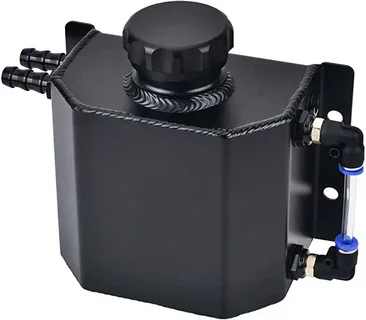Regarding vehicle maintenance, many drivers focus on the engine, brakes, and tyres. However, one crucial component often flies under the radar: the Tank. This unassuming part plays a significant role in your vehicle’s cooling system. Understanding its function can help you prevent costly repairs and ensure smooth driving experiences. Have you ever wondered how your car manages temperature fluctuations? The Overflow Tank is key to maintaining that balance. It serves as a reservoir for excess coolant, helping to regulate pressure within the cooling system. Neglecting this component could lead to overheating issues or even engine damage down the line.
What is an Tank?
An Tank, also known as a coolant reservoir, is essential to your vehicle’s cooling system. It’s typically made from durable plastic and is designed to hold excess coolant that may escape the central radiator during operation. This handy tank allows for the effective management of fluids in your car.
As the engine heats up, the coolant expands. When this happens, some fluid overflows into the tank instead of leaking onto the ground or causing damage elsewhere. The Tank is a safety net for this extra coolant, preventing potential overheating issues.
Most vehicles have specific markings to indicate minimum and maximum levels on their Tanks. Monitoring these levels can be crucial to ensure proper cooling system functioning. A well-maintained Tank helps prevent pressure buildup that could lead to serious engine problems.
In addition to holding surplus coolant, these tanks often feature a cap with a pressure release valve. This mechanism allows excess pressure to escape while keeping contaminants from the system.
Understanding how an Tank operates can help you appreciate its role in maintaining optimal engine temperatures and overall vehicle performance.
The Function of Coolant Tank
The Coolant Tank plays a critical role in a vehicle’s cooling system. Essentially, it acts as an expansion reservoir for coolant. As the engine heats up, coolant expands and pushes into this tank, helping manage the volume of fluid within the system.
When temperatures drop, that same coolant contracts. The Tank ensures there’s always enough fluid available to fill back into the cooling system without any air pockets forming. This balance prevents overheating and maintains optimal performance.
Another key function is pressure regulation. Coolant needs to be under specific pressure to operate effectively; too much pressure can lead to leaks or damage elsewhere in the system. The Tank helps absorb excess pressure fluctuations.
Additionally, these tanks serve as a monitoring point for coolant levels. If you notice low levels frequently, it may indicate other underlying issues, such as leaks or inefficient operation of your radiator cap.
They also contribute to environmental safety by containing excess fluids that could leak onto roadways or environments if uncontained—ensuring vehicles are more eco-friendly while on the move.
Preventing Overheating
Overheating can be a vehicle owner’s worst nightmare. An efficient Tank plays a pivotal role in preventing this issue. When your engine runs, it generates heat. The coolant absorbs this heat and circulates through the system to keep everything cool.
As the temperature rises, excess coolant expands into the Tank. This process ensures that there is always enough fluid available when needed. If your cooling system gets too hot, having an effective Tank helps maintain optimal operating temperatures.
Without a properly functioning Tank, you risk serious overheating problems. A malfunctioning or empty tank can lead to costly repairs and engine damage. Monitoring fluid levels regularly will help keep your vehicle in top shape.
When the coolant reaches its boiling point, pressure builds up within the system. The Tank releases some pressure safely while retaining necessary coolant for future use.
Regular checks on your vehicle’s cooling components are also essential. To prevent overheating, make sure hoses and connections are secure and free from leaks.
Maintaining System Pressure
Maintaining system pressure is crucial for an efficient vehicle cooling system. The Tank plays a significant role in this process. It helps manage the excess coolant generated as the engine heats up, preventing pressure from building too high within the radiator.
A properly functioning Tank ensures that coolant can flow freely back into the system as needed. This balance keeps temperatures stable, which protects against overheating. You also enhance your performance when your engine runs cooler and more efficiently.
If there is insufficient coolant in the Tank, it can lead to decreased pressure levels. Low pressure may cause boiling or vapour formation in the cooling system, compromising engine efficiency and longevity.
Regular inspection of your Tank is necessary to maintain optimal pressure levels. Check for leaks or cracks that might allow coolant to escape. Addressing these issues promptly can help prevent more significant problems down the line.
Remember that maintaining proper fluid levels not only aids in temperature regulation but also enhances overall vehicle safety and reliability on the road.
Coolant Management: Coolant Reservoir Tank
Coolant management is an essential aspect of vehicle maintenance. The Coolant Reservoir Tank plays a vital role in ensuring the cooling system operates efficiently. Proper coolant levels are crucial for preventing engine damage and maintaining optimal performance.
Monitoring the coolant level in your Tank regularly helps you identify leaks or other issues early on. If the level drops significantly, it may indicate a problem elsewhere in the cooling system, like a faulty radiator hose or water pump. Addressing these concerns promptly can save time and money later.
Additionausingt type of coolant for your vehicle. It is essential to make the required models specific for important eventuation correctly. Consult your owner’s manual to ensure you’re using compatible fluids.
It’s also wise to replace old coolant periodically. Over time, contaminants can accumulate, reducing its effectiveness at regulating temperature and preventing corrosion within the engine components.
By effectively managing your vehicle’s coolant through regular checks and proper maintenance practices, you can help extend its lifespan while keeping it running smoothly on every journey.
Signs of Tank Issues
An Tank is essential for your vehicle’s cooling system, and issues can arise that signal trouble. One of the first signs is a coolant leak. If you notice puddles underneath your car or a sudden drop in coolant levels, it may indicate a problem with the Tank.
Discoloured or Foamy Coolant
Another red flag is discoloured or foamy coolant. This change often means contamination or overheating, which can stem from a tank malfunction. Bubbles in the coolant might also hint at air pockets trapped in the system.
Temperature Gauge Readings
Temperature gauge readings are also crucial indicators. If your engine consistently runs hotter than usual, it could mean that the tank isn’t maintaining proper pressure. This scenario increases the risks of overheating and engine damage.
Strange Noises
Strange noises coming from under the hood shouldn’t be ignored, either. Unusual hissing sounds may suggest steam escaping due to excessive pressure buildup within the cooling system linked to an issue with your tank.
Regular Maintenance Tips of Coolant Overflow Tank
Regular maintenance of your Coolant Overflow Tank is crucial for optimal vehicle performance. Start by regularly checking the coolant level. Ensure it sits between the tank’s minimum and maximum markers. Low levels can lead to overheating, so keep an eye on this.
Next, inspect the Tank for any visible cracks or leaks. A damaged tank may not effectively hold pressure, which can affect your entire cooling system. If you notice any signs of wear, consider replacing it promptly.
Cleaning is another essential step in maintenance. Over time, dirt and debris can accumulate inside the tank. Periodically flush out old coolant and clean the interior with a soft brush or cloth to prevent clogs that might disrupt the flow.
Don’t overlook hose connections, either! Check all hoses leading to and from the Tank for signs of wear or degradation. Replace any cracked or brittle hoses, as they can compromise your cooling system’s efficiency.
Pay attention during regular service intervals at your mechanic’s shop. Ensure they include an inspection of your Tank and other cooling system components for comprehensive care.
Conclusion
Understanding the role of an overflow tank is crucial for any vehicle owner. It’s not just a simple component; it plays a significant part in the cooling system. When your engine heats up, the excess coolant needs to go somewhere. The Tank ensures that pressure levels remain stable and prevents potential damage. Neglecting this essential part can lead to overheating or even complete engine failure. Regular checks on coolant levels and inspecting for issues can save you from costly repairs. Incorporating routine maintenance also prolongs your vehicle’s lifespan. Monitoring your Tank ensures that everything runs smoothly under the hood.
FAQs
What is an overflow tank used for?
The overflow tank collects excess coolant that expands from the radiator as it heats up. It helps maintain a proper coolant level in the system, ensuring effective temperature regulation.
How do I know if my Tank is leaking?
Signs of a leak include visible puddles beneath your car or low coolant levels without apparent signs of overheating. Always check for cracks or damage on the tank itself.
Can I drive with a faulty Tank?
Driving with a damaged or malfunctioning Tank can lead to serious engine overheating issues. It’s best to address any problems immediately to avoid costly repairs.
How often should I check my Tank?
Regular checks during routine maintenance—like oil changes—are essential. Make them part of your checklist each time you inspect other fluid levels.
What type of coolant should I use in my Tank?
Always refer to your vehicle’s manual for recommended types and mixtures of coolant. Using the correct fluids ensures optimal performance and longevity.



